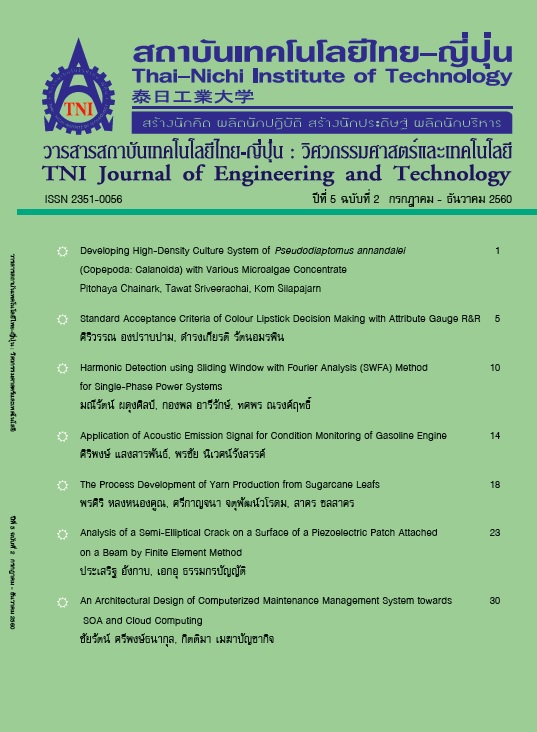The Process Development of Yarn Production from Sugarcane Leafs
Main Article Content
Abstract
This research aims to study the extraction of fiber from sugarcane leafs, the optimum amount of cotton to produce yarn from sugarcane leafs, There were two factors studied as; Sodium hydroxide used varying of 4 levels; 0.1, 0.2, 0.3, and 0.4% of the weights of the sugarcane leafs, and the time of boiling varying at 3 levels; 30, 60, and 90 minutes. The experiment used was Factorial in CRD 12 treatments based on % yield obtained. The optimum cotton yield in cane yarn production, the factors were study as the amount of cotton blended by varying at 5 levels; 10, 20, 30, 40, and 50. The selected by physical qualities; The extraction of sugarcane leafs gave the highest yield. Statisticall significant was at (P<0.05). The Sodium hydroxide content was 0.4% of the weights of the sugarcane leafs, and the time of boiling was 90 minutes The optimum cotton content was 30 percent. The uniformity grade F. The elongation was 11.38 %. The tensile strength was 4.24 Newton. The number of yarn was 0.94 Tex and The number of strands was 9.3 tpi.
Article Details
Article Accepting Policy
The editorial board of Thai-Nichi Institute of Technology is pleased to receive articles from lecturers and experts in the fields of engineering and technology written in Thai or English. The academic work submitted for publication must not be published in any other publication before and must not be under consideration of other journal submissions. Therefore, those interested in participating in the dissemination of work and knowledge can submit their article to the editorial board for further submission to the screening committee to consider publishing in the journal. The articles that can be published include solely research articles. Interested persons can prepare their articles by reviewing recommendations for article authors.
Copyright infringement is solely the responsibility of the author(s) of the article. Articles that have been published must be screened and reviewed for quality from qualified experts approved by the editorial board.
The text that appears within each article published in this research journal is a personal opinion of each author, nothing related to Thai-Nichi Institute of Technology, and other faculty members in the institution in any way. Responsibilities and accuracy for the content of each article are owned by each author. If there is any mistake, each author will be responsible for his/her own article(s).
The editorial board reserves the right not to bring any content, views or comments of articles in the Journal of Thai-Nichi Institute of Technology to publish before receiving permission from the authorized author(s) in writing. The published work is the copyright of the Journal of Thai-Nichi Institute of Technology.
References
“อ้อย,” 2557. [ออนไลน์]. แหล่งที่มา: https://www.kanchanapisek.or.th
สำนักงานคณะกรรมการอ้อยและน้ำตาลทราย, “รายงานพื้นที่ปลูกอ้อยประจำปีการผลิต 2555-56, 2556. [ออนไลน์]. แหล่งที่มา: https://www.ocsb.go.th/upload/journal/fileupload/923-2469.pdf
ละอองดาว แสงหล้า, “ผลกระทบจากการเผาใบอ้อยและแนวทางแก้ไข,”การจัดการสิ่งแวดล้อม, ปีที่ 2, ฉบับที่ 1, หน้า 85-102, 2548.
สุเมธ พรมจักร, ปาริตา เขื่อนเพชร, และจุฑามาศ ฟูคำ, การพัฒนาเส้นด้ายจากฟางข้าวไทย. ปทุมธานี: มหาวิทยาลัยเทคโนโลยีราชมงคลธัญบุรี, 2556.
เสาวนีย์ อารีย์จงเจริญ, นฤพน ไพศาลตันติวงศ์, รัตนพล มงคลรัตนาสิทธิ์, และสาคร ชลสาคร. “การพัฒนาสิ่งทอจากเส้นใยตะไคร้,” 2555. [ออนไลน์]. แหล่งที่มา: https://repository.rmutp.ac.th/bitstream/
สมพรวาสะสิริ, “ผืนผ้าจากเส้นใยผักตบชวาผสมด้ายฝ้าย,” วารสารศิลปกรรมศาสตร์วิชาการ วิจัย และงานสร้างสรรค์ราชมงคลธัญบุรี, ปีที่ 2, ฉบับที่ 1, หน้า 210–227, 2558.
สาคร ชลสาคร, “การผลิตเส้นด้ายและผืนผ้าจากใยไผ่,” 2552. [ออนไลน์]. แหล่งที่มา: https://library.dip.go.th/multim6/edoc/18727.pdf.
อัจฉริยา ม่วงพานิล, “การผลิตเส้นด้ายก้านโหม่งจาก,” วิทยานิพนธ์ คศ.ม. (เทคโนโลยีคหกรรมศาสตร์), มหาวิทยาลัยเทคโนโลยีราชมงคลธัญบุรี, ปทุมธานี, 2556.


